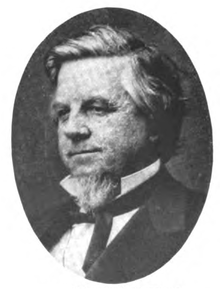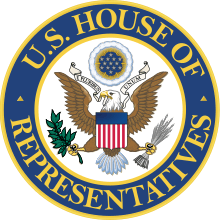David Kellogg Cartter
David Kellogg Cartter (June 22, 1812 – April 16, 1887) was a United States Representative from Ohio, Minister Resident of the United States to Bolivia and Chief Justice of the Supreme Court of the District of Columbia.
David Kellogg Cartter | |
|---|---|
 | |
| Chief Justice of the Supreme Court of the District of Columbia | |
| In office March 11, 1863 – April 16, 1887 | |
| Appointed by | Abraham Lincoln |
| Preceded by | Seat established by 12 Stat. 762 |
| Succeeded by | Edward Franklin Bingham |
| Minister Resident of the United States to Bolivia | |
| In office March 27, 1861 – March 10, 1862 | |
| Appointed by | Abraham Lincoln |
| Preceded by | John Cotton Smith |
| Succeeded by | Alen A. Hall |
| Member of the U.S. House of Representatives from Ohio's 18th district | |
| In office March 4, 1849 – March 3, 1853 | |
| Preceded by | Samuel Lahm |
| Succeeded by | George Bliss |
| Personal details | |
| Born | David Kellogg Cartter June 22, 1812 Jefferson County, New York |
| Died | April 16, 1887 (aged 74) Washington, D.C. |
| Resting place | Lake View Cemetery Cleveland, Ohio |
| Political party | Democratic (before 1860) Republican (from 1860) |
| Education | read law |
Education and career
Born on June 22, 1812, in Jefferson County, New York,[1] Cartter read law in 1832.[1] He was admitted to the bar and entered private practice in Rochester, New York from 1832 to 1836, and continued in private practice in Akron, Ohio from 1836 to 1845, and in Massillon, Ohio from 1845 to 1849.[1]
Congressional service
Cartter was elected as a Democrat from Ohio's 18th congressional district to the United States House of Representatives of the 31st and 32nd United States Congresses, serving from March 4, 1849, to March 3, 1853.[2] He was Chairman of the Committee on Patents for the 32nd United States Congress.[2]
Later career
Following his departure from Congress, Cartter resumed private practice in Massillon from 1853 to 1856, then in Cleveland, Ohio from 1856 to 1861.[1] He was a delegate to the 1860 Republican National Convention.[2] He served as Minister Resident of the United States to Bolivia from March 27, 1861, to March 10, 1862.[2][1]
Federal judicial service
Cartter was nominated by President Abraham Lincoln on March 10, 1863, to the Supreme Court of the District of Columbia (now the United States District Court for the District of Columbia), to the new Chief Justice seat authorized by 12 Stat. 762.[1] He was confirmed by the United States Senate on March 11, 1863, and received his commission the same day.[1] His service terminated on April 16, 1887, due to his death in Washington, D.C.[1] He was interred in Lake View Cemetery in Cleveland.[2]
References
- David Kellogg Cartter at the Biographical Directory of Federal Judges, a public domain publication of the Federal Judicial Center.
- United States Congress. "David Kellogg Cartter (id: C000206)". Biographical Directory of the United States Congress.
Sources
| Wikimedia Commons has media related to David Kellogg Cartter. |
- United States Congress. "David Kellogg Cartter (id: C000206)". Biographical Directory of the United States Congress.
- David Kellogg Cartter at the Biographical Directory of Federal Judges, a public domain publication of the Federal Judicial Center.
- David Kellogg Cartter at Find a Grave
- Wilson, J. G.; Fiske, J., eds. (1900). . Appletons' Cyclopædia of American Biography. New York: D. Appleton.
| U.S. House of Representatives | ||
|---|---|---|
| Preceded by Samuel Lahm |
Member of the U.S. House of Representatives from Ohio's 18th congressional district 1849–1853 |
Succeeded by George Bliss |
| Diplomatic posts | ||
| Preceded by John Cotton Smith |
Minister Resident of the United States to Bolivia 1861–1862 |
Succeeded by Allen A. Hall |
| Legal offices | ||
| Preceded by Seat established by 12 Stat. 762 |
Chief Justice of the Supreme Court of the District of Columbia 1863–1887 |
Succeeded by Edward Franklin Bingham |
